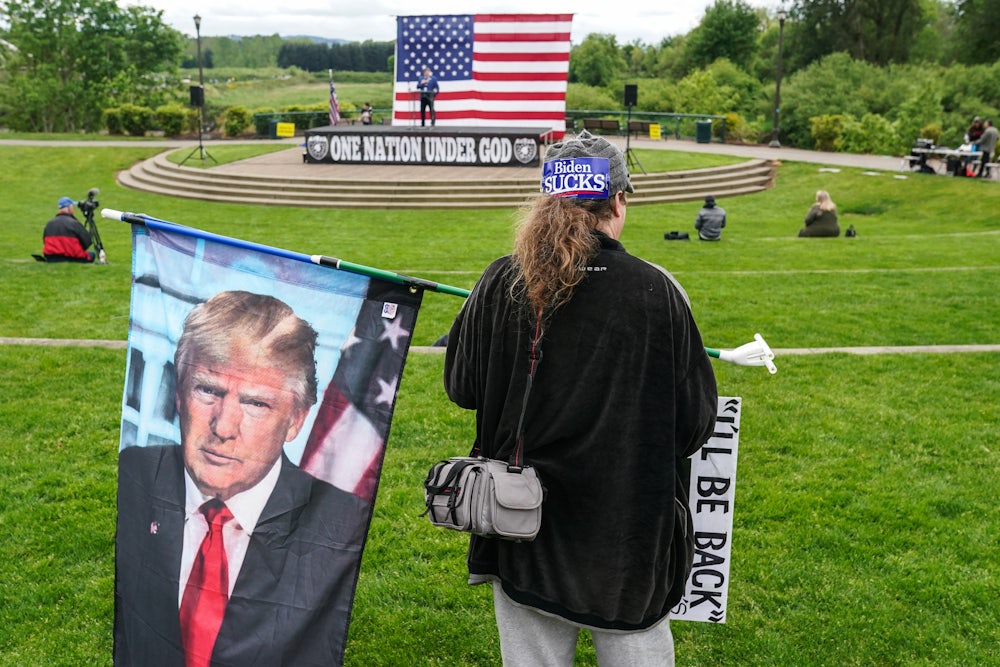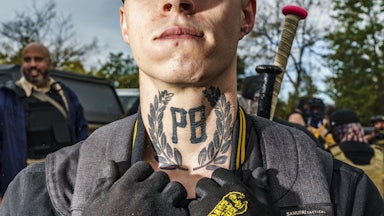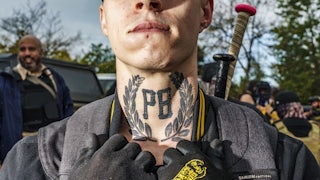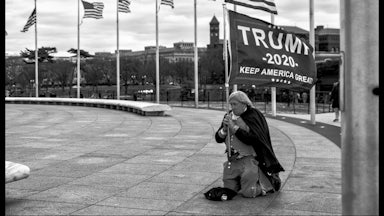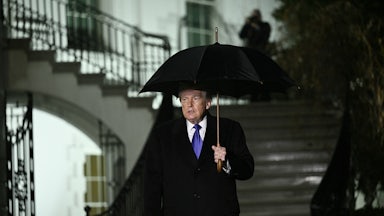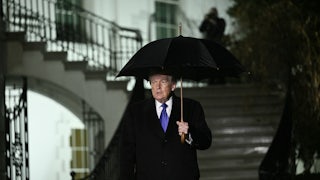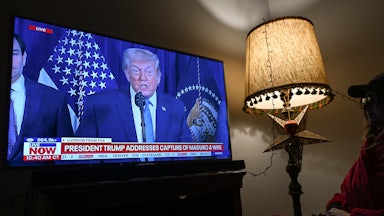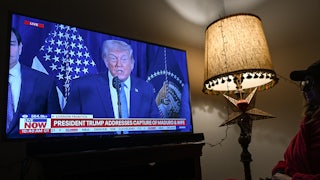The deep chasm in American political culture continues to open, and to generate irreconcilable positions on everything from climate change to Covid-19 to critical race theory. The intensity of this divide is driven largely by the zeal of the right and its appetite to remake the polity in its image, leaving Democrats and liberals as defenders of the American political system.
Nowhere is this clearer than the January 6 insurgency and the meanings made of it seven months later. A recent Quinnipiac poll held that 84 percent of Democrats consider the events of that day to be “an attack on democracy that should never be forgotten,” while other polls show that Republican use of such terms as “patriotism” and “defense of freedom” to describe it continue to gain popularity.
Were the events that day an attempted putsch or an extravagant fit of democratic passions? While it requires us to face some uncomfortable truths about our own democratic myths, perhaps we should consider the possibility that they were both.
The testimony of the Capitol Police, presented during the dramatic first day of House hearings on the January 6 insurrection, confirmed the most dire liberal assumptions about the rioters: They were rageful, vicious, and in some cases clearly driven by racial animus. Theirs was the national vanguard of a growing anti-democratic force in U.S. politics, one that launched an assault on the American political system itself, seeking to negate the will of the voters in the 2020 presidential election.
But to treat the movement that gave rise to the insurrection as alien to American politics and culture would be to miss something crucial about what animates its partisans and makes them dangerous. The United States is currently in a moment of intense political division. As this divide grows, the most ardent opponents of voting rights, social protest, and teaching the history and present of racial domination in our schools act in the name of the insurrectionary energy of the American Revolution. Exploring this paradox can both help us understand the trajectory of the contemporary right and better think through principles and strategies to combat it.
The origin of the right-wing movement that unites Proud Boys, militias, Blue Lives Matter police nationalists, and, frankly, the current mass of the Republican Party is not Donald Trump’s 2016 presidential candidacy but the 2009 Tea Party movement. At the time, the cosplay quality of its participants, from the tricorn hats to the Gadsen “Don’t Tread on Me” flags, seemed like a harmless, even laughable feature. But the myths of the founding embraced by the Tea Party are perhaps the most sustaining force in the imaginary of the contemporary far right—particularly now as it is faced with the growing popularity of a counter–national origin story: that of 1619.
It is “precisely in such epochs of revolutionary crisis they anxiously conjure up the spirits of the past to their service,” Marx said about the coup of Louis-Napoleon Bonaparte in 1851, “borrowing from them names, battle slogans, and costumes in order to present this new scene in world history in time-honored disguise and borrowed language.”
Trump was a product of this movement, having been a prominent purveyor of the “birther” conspiracy. As a presidential candidate, he used the language of popular sovereignty to combat other institutions of government and claim representation of the common man against the machinations of elites. Rather than call for a national refounding of the republic, as the Tea Party had, he offered himself as Caesar, who alone could cure the nation’s ills. He also embodied a slightly different sense of the nation’s founding than the Tea Party’s—one that emphasized genetic over political origins, racial rage over racial denial.
Trump’s racial signaling, which was magnified by luminaries in his circle, such as Steve Bannon, Jeff Sessions, and Stephen Miller, emboldened a new, openly racist alt-right movement that sought to extend and radicalize the new administration’s tendencies in this direction. The alt-right marched confidently from the internet message boards and into the street, but its direct influence would be short-lived.
Two weeks before the infamous Unite the Right rally in Charlottesville, Virginia, in the summer of 2017, the white supremacist American Renaissance magazine held a conference outside Nashville, Tennessee. Prior to Trump’s election, this obscure “race realist” journal had a tiny membership of eugenic pseudoscientists and Aryan mythmakers. Now it pulsed with the energy of new relevance. Rumpled, older race polemicists mingled with physically fit young men sporting “high and tight” haircuts and clustering around new celebrity leaders like Richard Spencer. The notoriously violent Nathan Damigo, founder of the white supremacist Identity Evropa, gave a detailed slide presentation about his organization’s new 50-state college campus recruitment strategy. Former Forbes editor Peter Brimelow, the founder of the anti-immigrant website VDare, gave Trump a “C-” for his efforts on immigrant restriction and deportation thus far, but was optimistic for where things were headed. There was a giddiness about the prospects of the newly militant racist right, itching to prove its ferocity.
Alas, the events in Charlottesville would prove disastrous for dreams of a white utopia. The weekend that began with a torchlight march and chants of “Jews will not replace us” and ended with the vehicular manslaughter of anti-fascist activist Heather Heyer by neo-Nazi James Fields Jr. made for a calamitous debut of this new movement. Their vision of politics, rooted more in European-imported racial-purity myths than American national identity, would be denounced by nearly everyone, except perhaps Trump himself.
In a nation founded on slavery and Indigenous genocide, white supremacy has always been a constitutive piece of American national identity, but it cannot be openly claimed in a nation also founded on belief in democracy and freedom. This is particularly true in the post–civil rights era, when the attachment to what James Baldwin called “white innocence” has only grown more intense.
In the months following the Charlottesville debacle, much of this movement collapsed in on itself under lawsuits, public condemnation, and infighting. As Andrew Anglin, founder of the neo-Nazi website The Daily Stormer, was forced to admit to his readership months later, “Armband neo-Nazism is never going to be that popular.”
But out of these ashes, a different political vision for the far right would coalesce—one that would reject white supremacy as an ideology and seek out the more generative ground of American nationalism as an alternative.
Nationalism always operates, as historian Benedict Anderson put it, as an “imagined community,” connecting strangers in a settled sense of common identity through shared myths, memorials, and other cultural artifacts. But just as national identity can stabilize and cohere, it can also be used to disrupt and make new demands. This is perhaps particularly true in the case of the U.S., where the Revolution and its sacred justifying text, the Declaration of Independence, has been used regularly by various movements—from suffrage to civil rights to ecology—to authorize political and social change.
Yet democratic myths of the founding have lost currency with the left over the last half-century as activists and intellectuals have grappled with U.S. legacies of colonialism and slavery, capitalism and empire. Meanwhile, their potential value on the right has grown as their partisans have come to imagine themselves as victims of illegitimate state power and as small-r republican patriots whose policy preferences, from health care to taxation, from affirmative action to gun rights, can be imagined through a revolutionary frame of disruptive resistance.
After 2017, various factions on the right began to gather under the banner of nationalism. The Proud Boys, once mocked as being soft on the race question by white nationalist groups in their milieu, began to replace white supremacists as the dominant force in this movement, presenting themselves not just as urban “Western chauvinists” in Fred Perry polo shirts who opposed Islam, immigration, and international communism, but as defenders of the American nation and its president, Donald Trump. The white hipster Canadian founder of the Proud Boys, Gavin McGinnes, would finally come to be replaced by a U.S. citizen of Afro-Cuban parentage, Enrique Tarrio, who in turn became a major proponent of the Stop the Steal campaign in the weeks before January 6.
The modern militia movement found its way to contemporary far-right nationalism from another direction. When Ammon Bundy and his followers led an armed takeover of the Malheur Wildlife Refuge in eastern Oregon in 2016, the animating issue was the arson case against Dwight and Stephen Hammond, cattle ranchers who were sentenced to five years in prison for setting fires on federal land. The Malheur occupation, which resulted in the killing of Lavoy Finicum by federal agents, was oriented against the Bureau of Land Management (and mandatory-minimum sentencing) on behalf of a Western settler colonial fantasy of the unimpeded right to water, grazing land, mining, and timber extraction.
Although Malheur took place during the primary season in 2016, there was no discussion of Donald Trump among the occupiers in any of the voluminous interviews they gave, let alone any mention of the fortunes of the Republican Party. But the Three Percenters, Oath Keepers, and other “Patriot groups” who brandished arms in the high desert of southeastern Oregon in defense of ranchers would soon find themselves defending the president and the electoral fortunes of the GOP.
This new movement took the Tea Party’s insurrectionary dress-up and replaced it with the threat of real violence. The killings of George Floyd and Breonna Taylor, and the massive social movement that rose up in protest, ignited these far-right movements in response. Right-wing vigilantes took to the streets claiming to defend civil order and private property from what they depicted as the mob violence and Marxist agenda of Black Lives Matter and antifa. Unlike the violence of the openly racist alt-right three years before, this was a broad-based social movement whose racial animus could be plausibly denied.
Upward of 17,000 anti–Black Lives Matter counterprotesters were on the streets that summer. They came in mossy oak camouflage and Kevlar, with firearms and bear spray, their heraldry aloft: Trump 2020, Blue Lives Matter, American, Gadsden, and Confederate flags. While their numbers were dwarfed by the 15 to 26 million people who participated in Black Lives Matter protests, the threat of violence these counterprotesters posed was all too real. In all, there were 679 documented violent attacks on Black Lives Matter activists across the summer, including 86 vehicular assaults and 10 shootings. In many places, these right-wing militants coordinated closely with the police forces they showed up to support.
The most brutal attack in the summer of 2020 was by 17-year-old Kyle Rittenhouse, who shot two protesters dead and wounded a third in Kenosha, Wisconsin, during a demonstration against the police for shooting and paralyzing Jacob Blake, a young African American man.* Hours before the shootings, Rittenhouse was interviewed by the Daily Caller, where he earnestly explained his intent: “People are getting injured and our job is to protect this business. And my job also is to protect people. If someone is hurt, I’m running into harm’s way. That’s why I have my rifle; I’ve gotta protect myself, obviously. But I also have my med kit.”
Tucker Carlson was first to praise Rittenhouse. “How shocked are we that 17-year-olds with rifles decided they had to maintain order when no one else would?” Rittenhouse’s mother was given a standing ovation at a GOP event in Waukesha, Wisconsin, and praised by state and national GOP officials, including Trump himself. Immediately, conservative organizations began raising hundreds of thousands of dollars in legal funds on his behalf.
It’s a stark contrast to how the public and the right responded to the killing of Heather Heyer. In both incidents, a far-right activist intentionally killed anti-racist demonstrators. But Heyer’s killer openly identified with white supremacy, thus offering a motive well beyond what most Americans are willing to countenance. Even Trump Attorney General Jeff Sessions said, “The violence and deaths in Charlottesville strike at the heart of American law and justice. When such actions arise from racial bigotry and hatred, they betray our core values and cannot be tolerated. Justice will prevail.”
Rittenhouse, by contrast, blurred the distinction between racial nationalism and civic nationalism by claiming to act not as a white supremacist but rather as a defender of people and property, and thus as an emblem of cherished American values of voluntarism and community care. Where Fields looked like a European import with his Hitlerian haircut and membership in a fascist group, the cherub-cheeked, grinning Rittenhouse with the backward ball cap and red, white, and blue Crocs looked like an extra from the Netflix mystery teen drama Outer Banks.
During the summer, rapidly growing numbers of individuals and groups were incorporated into the far-right fold at nationwide demonstrations against pandemic restrictions, including evangelicals who wanted their churches open, business owners who wanted their customers back, and inconvenienced individuals newly open to libertarian interpretations of state control over their lives. At these rallies, Three Percenters with long guns, gym-swollen Proud Boys, strident QAnon adherents, countercultural anti-vaxxers, Trump supporters, evangelicals, and business conservatives found shared purpose in protest, while navigating their own internal differences.
Ultimately, the insurgent movement turned on the party system itself, as anger toward Democrats intensified among right-wing activists and Republican voters. In April, heavily armed militants rushed the Michigan statehouse to protest lockdown orders, and militant protests followed at other state capitols in the months to come. In August, Ammon Bundy led members of his newly formed People’s Rights Network in a series of intrusions into the Idaho statehouse while it was in special session. In December, armed protesters faced off with state police in the Oregon Capitol building after being let in through a side door by a Republican lawmaker. In each case, protesters justified their actions as collective expressions of popular sovereignty.
So how do we square these two facts: that the January 6 insurgency was a violent, anti-democratic juggernaut and that its insurgents saw themselves as saving a democratic republic? This brings us to Niccolo Machiavelli, whose republican idea of the necessity of periodic refoundings runs deep in American political culture. This idea of a “return to first principles” requires a repetition of the extra-legal violence through which the regime was originally established, the better to overcome the corruption of elites, restore the integrity of the law, and reestablish the sovereignty of the people.
As Ammon Bundy put it, “Maybe they needed a reminder by us, but this is something that’s traditional in our country that our founders did—reasserting the premise that the people are the ones who are sovereign.”
Binding past and present, the refounding violence on the right allows radical new action in the name of tradition. Yet this narrative of decline and refounding actively forgets the corruption of slavery and Indigenous genocide that was present at the founding. This is how the right can have an Afro-Cuban leader of the Proud Boys and an African American leader of the Stop the Steal campaign and still be laser-focused on denying Black and brown votes, suppressing anti-racist protest, and teaching the history of slavery and its enduring legacies in our schools.
It may be that there is no identification with the U.S. founding that does not repeat this appeal to white innocence. If that’s the case, where can a truly democratic, emancipatory political vision be planted and nurtured?
If we recall the extraordinary size, energy, and character of the Black Lives Matter movement in the summer of 2020—a Black-led, woman-led, multiracial phenomenon that put fundamental questions on the table about our racial history and present—we can see not one but two powerful origin stories at work in the U.S. political life: 1776 and 1619. The latter is a story of original sin, no doubt, but many generations of rebels have drawn inspiration and guidance from its legacy of subversion, refusal, fugitivity, and resistance; of insurrection, abolition, and Reconstruction. The vistas opened by this inheritance have always expanded democratic freedoms for other groups.
In truth, there are many ways in which the U.S. looks democratically threadbare these days, whether it is the weighted process of choosing a president, a dysfunctional Congress in the pocket of lobbyists, a partisan Supreme Court, or the extraordinary political power wielded by a class of multibillionaires. One thing is clear: Attempting to defend an already undemocratic system from right-wing insurgents without addressing the profound inequality and asymmetries of power will neither quell that insurgency nor make possible the kinds of democratic future we need.
* This article originally mischaracterized Blake’s injuries.
